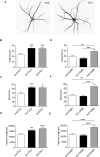Increased signaling by the autism-related Engrailed-2 protein enhances dendritic branching and spine density, alters synaptic structural matching, and exaggerates protein synthesis
- PMID: 28809922
- PMCID: PMC5557355
- DOI: 10.1371/journal.pone.0181350
Increased signaling by the autism-related Engrailed-2 protein enhances dendritic branching and spine density, alters synaptic structural matching, and exaggerates protein synthesis
Abstract
Engrailed 1 (En1) and 2 (En2) code for closely related homeoproteins acting as transcription factors and as signaling molecules that contribute to midbrain and hindbrain patterning, to development and maintenance of monoaminergic pathways, and to retinotectal wiring. En2 has been suggested to be an autism susceptibility gene and individuals with autism display an overexpression of this homeogene but the mechanisms remain unclear. We addressed in the present study the effect of exogenously added En2 on the morphology of hippocampal cells that normally express only low levels of Engrailed proteins. By means of RT-qPCR, we confirmed that En1 and En2 were expressed at low levels in hippocampus and hippocampal neurons, and observed a pronounced decrease in En2 expression at birth and during the first postnatal week, a period characterized by intense synaptogenesis. To address a putative effect of Engrailed in dendritogenesis or synaptogenesis, we added recombinant En1 or En2 proteins to hippocampal cell cultures. Both En1 and En2 treatment increased the complexity of the dendritic tree of glutamatergic neurons, but only En2 increased that of GABAergic cells. En1 increased the density of dendritic spines both in vitro and in vivo. En2 had similar but less pronounced effect on spine density. The number of mature synapses remained unchanged upon En1 treatment but was reduced by En2 treatment, as well as the area of post-synaptic densities. Finally, both En1 and En2 elevated mTORC1 activity and protein synthesis in hippocampal cells, suggesting that some effects of Engrailed proteins may require mRNA translation. Our results indicate that Engrailed proteins can play, even at low concentrations, an active role in the morphogenesis of hippocampal cells. Further, they emphasize the over-regulation of GABA cell morphology and the vulnerability of excitatory synapses in a pathological context of En2 overexpression.
Conflict of interest statement
Figures







References
-
- Abrahams BS, Geschwind DH. Advances in autism genetics: on the threshold of a new neurobiology. Nat Rev Genet. 2008; 9: 341–355. doi: 10.1038/nrg2346 - DOI - PMC - PubMed
-
- Penzes P, Cahill ME, Jones KA, VanLeeuwen J-E, Woolfrey KM. Dendritic spine pathology in neuropsychiatric disorders. Nat Neurosci. 2011; 14: 285–293. doi: 10.1038/nn.2741 - DOI - PMC - PubMed
-
- Bourgeron T. A synaptic trek to autism. Curr Opin Neurobiol. 2009; 19: 231–234. doi: 10.1016/j.conb.2009.06.003 - DOI - PubMed
-
- Ebert DH, and Greenberg ME. Activity-dependent neuronal signalling and autism spectrum disorder. Nature 2013; 493: 327–337. doi: 10.1038/nature11860 - DOI - PMC - PubMed
MeSH terms
Substances
LinkOut - more resources
Full Text Sources
Other Literature Sources
Molecular Biology Databases

